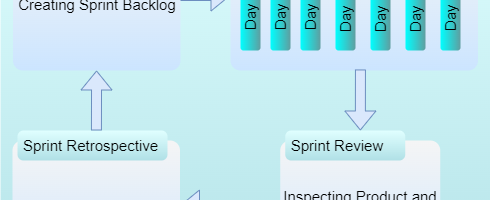The Scrum Guide – 2020
The Sprint is a container for all other events. Each event in Scrum is a formal opportunity to inspect and adapt Scrum artifacts. These events are specifically designed to enable the transparency required. Failure to operate any events as prescribed results in lost opportunities to inspect and adapt. Events are used in Scrum to create regularity and to minimize the need for meetings not defined in Scrum.
Optimally, all events are held at the same time and place to reduce complexity.
© 2020 Ken Schwaber and Jeff Sutherland
Commentary
In the early days, Scrum was often criticized for inducing too many meetings. “You have a 2-week long sprint with 3-4 large and 10 small meetings. When do you have time to work?” In this section, we receive the response to these critics:
- Scrum events largely eliminate the need for other meetings;
- Scrum events are time-boxed and thus never can stretch too long, which is especially critical for the daily scrums.
From a theoretical point of view, it is debatable whether a Sprint is really an event or just a logical unit, “a container for all other events”. Whichever opinion we agree with, does not have a practical impact on the process.
The Scrum events within the Sprint are:
- Sprint Planning (once every Sprint)
- Daily Scrum (every day)
- Sprint Review (once every Sprint)
- Sprint Retrospective (once every Sprint)

Note that the events are not called ceremonies or meetings anymore.
Some practitioners consider backlog refinement an event, too. The Guide does not indicate that refinement should take place as an event. It is rather an ongoing process, however, often backed up by a team meeting.
FAQ
As we can see, not all the events are held at the same time and place, that would be a tad bit chaotic. All events, respectively, are recurring without unnecessary changes.
For no particular reason, in the early days of Scrum, a team of Jeff Sutherland named the iteration this way. It kind of refers to the short length and the intensity of work. It is not about rush, but about a ‘visible’, near-term goal.
The loop simply refers to repeating the process over and over again. It is not a flowchart where the loop would take us back somewhere we have been before.
Key Takeaways
- The Sprint is the container event of the other four events, Sprint Planning, Daily Scrum, Sprint Review, and Sprint Retrospective.
- Optimally the events are recurring without variations.
- Events create transparency and serve the goal of inspection and adaptation.
The Scrum Guide – 2017
Scrum Events
Prescribed events are used in Scrum to create regularity and to minimize the need for meetings not defined in Scrum. All events are time-boxed events, such that every event has a maximum duration. Once a Sprint begins, its duration is fixed and cannot be shortened or lengthened. The remaining events may end whenever the purpose of the event is achieved, ensuring an appropriate amount of time is spent without allowing waste in the process.
Other than the Sprint itself, which is a container for all other events, each event in Scrum is a formal opportunity to inspect and adapt something. These events are specifically designed to enable critical transparency and inspection. Failure to include any of these events results in reduced transparency and is a lost opportunity to inspect and adapt.
©2017 Ken Schwaber and Jeff Sutherland.
The Scrum Guide – 2010
Time-Boxes
The Time-Boxes in Scrum are the Release Planning Meeting, the Sprint, the Sprint Planning Meeting, the Sprint Review, the Sprint Retrospective, and the Daily Scrum.
© 2008-2010 Ken Schwaber and Jeff Sutherland, All Rights Reserved
